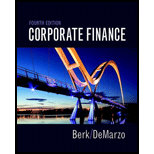
Corporate Finance (4th Edition) (Pearson Series in Finance) - Standalone book
4th Edition
ISBN: 9780134083278
Author: Jonathan Berk, Peter DeMarzo
Publisher: PEARSON
expand_more
expand_more
format_list_bulleted
Question
Chapter 10.2, Problem 2CC
Summary Introduction
To discuss: The two common measures of risk and how it is related to each other.
Introduction:
Risk refers to the movement or fluctuation in the value of an investment. The movement can be positive or negative. A positive fluctuation in the price benefits the investor. The investor will lose money if the price movement is negative.
Expert Solution & Answer
Want to see the full answer?
Check out a sample textbook solution
Students have asked these similar questions
I need answer for this qn
Take 1.01^-36 =0.699 value
Need answer plz solve
Chapter 10 Solutions
Corporate Finance (4th Edition) (Pearson Series in Finance) - Standalone book
Ch. 10.1 - For an investment horizon from 1926 to 2012, which...Ch. 10.1 - For an investment horizon of just one year, which...Ch. 10.2 - Prob. 1CCCh. 10.2 - Prob. 2CCCh. 10.3 - How do we estimate the average annual return of an...Ch. 10.3 - Prob. 2CCCh. 10.4 - Prob. 1CCCh. 10.4 - Do expected returns of well-diversified large...Ch. 10.4 - Do expected returns for Individual stocks appear...Ch. 10.5 - What is the difference between common risk and...
Ch. 10.5 - Prob. 2CCCh. 10.6 - Explain why the risk premium of diversifiable risk...Ch. 10.6 - Why is the risk premium of a security determined...Ch. 10.7 - What is the market portfolio?Ch. 10.7 - Define the beta of a security.Ch. 10.8 - Prob. 1CCCh. 10.8 - Prob. 2CCCh. 10 - The figure on page informalfigure shows the...Ch. 10 - Prob. 2PCh. 10 - Prob. 3PCh. 10 - Prob. 4PCh. 10 - Prob. 5PCh. 10 - Prob. 6PCh. 10 - The last four years of returns for a stock are as...Ch. 10 - Prob. 9PCh. 10 - Prob. 10PCh. 10 - Prob. 11PCh. 10 - How does the relationship between the average...Ch. 10 - Consider two local banks. Bank A has 100 loans...Ch. 10 - Prob. 21PCh. 10 - Prob. 22PCh. 10 - Consider an economy with two types of firms, S and...Ch. 10 - Prob. 24PCh. 10 - Explain why the risk premium of a stock does not...Ch. 10 - Prob. 26PCh. 10 - Prob. 27PCh. 10 - What is an efficient portfolio?Ch. 10 - What does the beta of a stock measure?Ch. 10 - Prob. 31PCh. 10 - Prob. 32PCh. 10 - Prob. 33PCh. 10 - Suppose the risk-free interest rate is 4%. a. i....Ch. 10 - Prob. 35PCh. 10 - Prob. 36PCh. 10 - Suppose the market risk premium is 6.5% and the...Ch. 10 - Prob. 38P
Knowledge Booster
Similar questions
arrow_back_ios
SEE MORE QUESTIONS
arrow_forward_ios
Recommended textbooks for you
- Business Its Legal Ethical & Global EnvironmentAccountingISBN:9781305224414Author:JENNINGSPublisher:Cengage
 Auditing: A Risk Based-Approach (MindTap Course L...AccountingISBN:9781337619455Author:Karla M Johnstone, Audrey A. Gramling, Larry E. RittenbergPublisher:Cengage Learning
Auditing: A Risk Based-Approach (MindTap Course L...AccountingISBN:9781337619455Author:Karla M Johnstone, Audrey A. Gramling, Larry E. RittenbergPublisher:Cengage Learning Cornerstones of Financial AccountingAccountingISBN:9781337690881Author:Jay Rich, Jeff JonesPublisher:Cengage Learning
Cornerstones of Financial AccountingAccountingISBN:9781337690881Author:Jay Rich, Jeff JonesPublisher:Cengage Learning  EBK CONTEMPORARY FINANCIAL MANAGEMENTFinanceISBN:9781337514835Author:MOYERPublisher:CENGAGE LEARNING - CONSIGNMENTPrinciples of Accounting Volume 2AccountingISBN:9781947172609Author:OpenStaxPublisher:OpenStax College
EBK CONTEMPORARY FINANCIAL MANAGEMENTFinanceISBN:9781337514835Author:MOYERPublisher:CENGAGE LEARNING - CONSIGNMENTPrinciples of Accounting Volume 2AccountingISBN:9781947172609Author:OpenStaxPublisher:OpenStax College

Business Its Legal Ethical & Global Environment
Accounting
ISBN:9781305224414
Author:JENNINGS
Publisher:Cengage

Auditing: A Risk Based-Approach (MindTap Course L...
Accounting
ISBN:9781337619455
Author:Karla M Johnstone, Audrey A. Gramling, Larry E. Rittenberg
Publisher:Cengage Learning

Cornerstones of Financial Accounting
Accounting
ISBN:9781337690881
Author:Jay Rich, Jeff Jones
Publisher:Cengage Learning

EBK CONTEMPORARY FINANCIAL MANAGEMENT
Finance
ISBN:9781337514835
Author:MOYER
Publisher:CENGAGE LEARNING - CONSIGNMENT

Principles of Accounting Volume 2
Accounting
ISBN:9781947172609
Author:OpenStax
Publisher:OpenStax College
